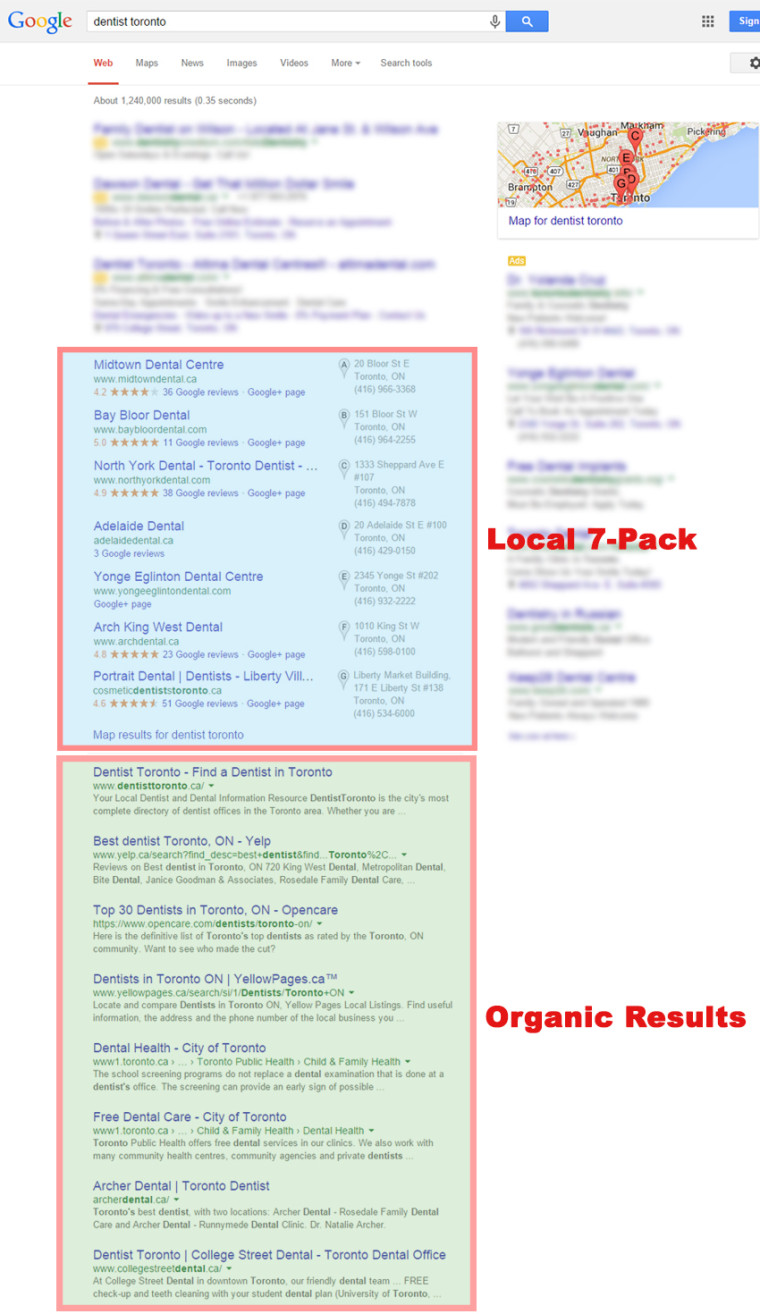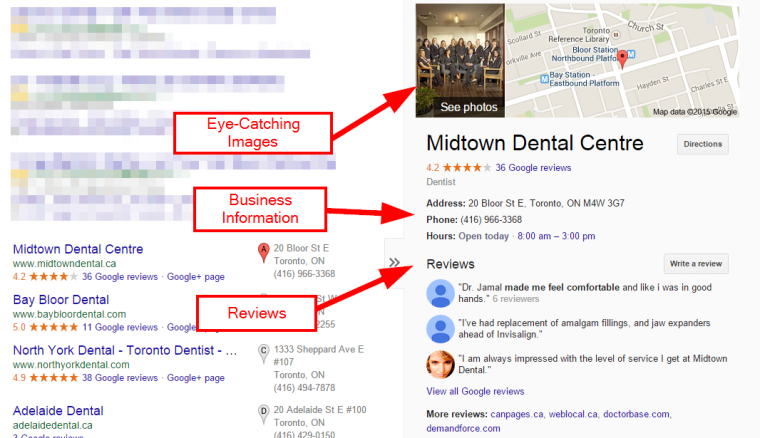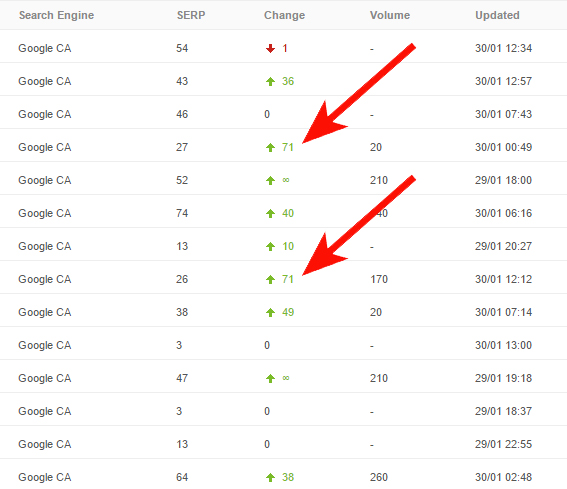If you run a local business, then you need to be doing local SEO. This article will cover the basics and give you some quick action items that you can do, even if you’re non-tech savvy.
What is Local SEO?
Local SEO is the process of optimizing your business so it shows up in the search engines to people searching locally for your services.
Whether you’re a dentist, restaurant, or yoga studio, the only customers that matter for your business are people searching within your city, and because of that, you need to focus your SEO locally where it matters.
Organic Results vs. The Local 7-Pack
Most search engines will have two sets of results when it comes to a local search – the organic results and the Local 7-Pack.
Take a look at the image below to understand what I mean:
As you can see, the Local 7-Pack only features local businesses that have signed up with Google (we’ll get into that later), whereas the organic results display the most relevant results across the web. This includes directories (i.e. Yellow Pages), review sites (i.e. Yelp) and of course, other local businesses.
Ideally, you want your website to be optimized for both the organic and Local 7-Pack so that you cover more real estate on the search page.
Sidenote: If you’re clever, you’ll even take this one step further and make sure your business is one of the top listings on Yelp and the Yellow Pages (Yelp is 2nd in the organic results and Yellow Pages is 4th – using the example above).
There are hundreds of reasons why other businesses show up in the search results and yours don’t. Below are some action items you can execute right away that will help increase your chances of showing up on the Local 7-Pack.
Laying The Foundation
As I mentioned above, the 7-Pack only features local businesses that have signed up with Google. It’s surprising how many local businesses I speak to every week that haven’t done this, because it takes literally five minutes to sign up, and it’s free. Here are the steps to do this.
Check for an Existing Listing
Before we go ahead and start creating new listings, let’s first find out what is out there about our business.
To do this, go to Google.com/business and sign in. Enter your phone number in the search box (most people enter their business name, which can be misleading). Here’s an example why:
If you enter “Dr. Muyal Associates†(the business name of a dental practice I came across in Toronto), it will come up with one hit. Based on their website however, they have two locations – one in Toronto and one in Thornhill.

If they just entered their business name, they could easily be misled in thinking that they are missing a business listing for their Thornhill address.
When I put in their Thornhill phone number however, their Thornhill listing now shows up, just under a different business alias.

It’s always better to put in the phone number as you never know what may have been entered as the business name.
In this case, this dental practice has both locations already set up so they can skip the next step which is registering their business with Google.
Side Note: It may be a good idea, however, for Dr. Muyal Associates to login or call Google to fix up their business names so that both locations are consistent.
Register For Google Business
Now that we have checked and not found our business, we’ll go ahead and add it.
- Go to Google.com/business
- Select “Get On Googleâ€
- Sign in or create an account
- Type in the name of your business – in this case, we’ll use a fiction business as an example
- Since we already checked and found that our business does not exist in the section above you can go ahead and select add your business:
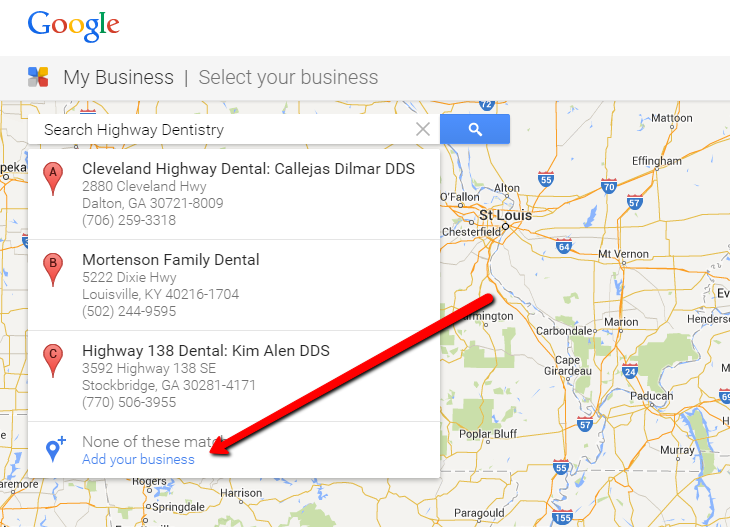
- Fill in your business details (name, address, etc.).
- Hit continue and have Google send you a postcard. This will contain your PIN number to verify your location. Once you receive it, enter it in to confirm your location.
Fill in Your Profile While You Wait For Verification
You’ll typically need to wait about two weeks for your postcard to come in, but that doesn’t mean there isn’t work to be done in the meantime. You can make use of this time to thoroughly fill out your listing.
This helps customers and Google understand your business.
Here are some tips when filling out your profile:
- Accurately fill in your hours (most people gloss over this, but if your business is shown as closed when it’s actually open, then you can be missing out on customers)
- Make sure you are showing up under the correct category. This is one criteria that Google uses to determine how relevant you are to the search.
- Put in a thorough description with your keywords, but don’t keyword stuff.
Building Your Local Presence
Now that Google knows about your business, you can further improve your relevance by using the following strategies.
1. Build Citations
A citation is a mention of your business on the web. This does not have to include a link, and can simply be a mention of your company, or it could be a full listing of your company name, address phone number, and website.
Citations are like validation for your business. It tells Google that you are a legitimate business and are part of a community.
Adding Citations
Not all citations are created equally. In other words, if you were a dentist in Toronto and your business was mentioned in a Toronto dental directory, then that would be much more beneficial than a generic, worldwide directory.
Here is a comprehensive list of citations from my company, Search Highway, that are free. Simply add your business name and details.
Take note that when adding citations, you want your business name to be exactly the same everywhere on the web. This is the same for your address and phone number.
Pro Tip:Â Citations, just like your Google listing can contain duplicates. Before adding any new listing, check to see if it exists on that website by typing in your business name.
Paid Services
As adding your business to listings can be quite a tedious task, you can pay to have it done for you instead. Either one of the following services are great – each with their pros and cons, but all generally the same.
2. Add Locality On Your Website
Many people often forget to add their city/state on their website. This simple technique tells Google that you are local to the city and you can see some significant jumps in both the organic and local searches just by doing this.
Below is an example client that saw huge jumps (as much as 7 pages) by simply adding their city/state to the website title tag. Best of all, this change only took five minutes.
In summary, we recommend adding your city/state to:
- Your title tag
- Your H1 tag
- Your content
Note: I’m not suggesting you keyword stuff your content! Simply add in your city/state as necessary to drive relevancy signals.
3. Add Schema Markup
Schema markup simply helps Google understand your website better. By adding specific markup tags, you’re telling Google which part of your website is your address, which part is the phone number, which part is the business name etc.
Although this sounds complicated, there’s an incredibly simple way to do this.
- Go to http://schema-creator.org/
- Choose organization and select Local Business
- Fill in the details and copy and paste the code on the right on your website
- …and you’re done! You now have schema markup on your website
 4. Get Reviews
Reviews are an important aspect of the Local 7-Pack ranking algorithm. The more the merrier.
More importantly though, consumers love to read reviews. In fact, “88% Of Consumers Trust Online Reviews As Much As Personal Recommendationsâ€Â according to a study by Bright Local. So make sure you have a system in place for your business to collect reviews online.
Conclusion
Although there are definitely more advanced strategies you can use, these simple steps will put you way ahead of most other local businesses. Don’t wait to get this started – businesses that adapt the quickest thrive.
Got questions? Let me know below!
Â
Image Credits
Featured Image: Created by author for Search Engine Journal
All screenshots taken March 2015
Related Posts
 Keep It All Straight and Get Started with the Locals: Yahoo Local, Yelp, Google+ Local
Keep It All Straight and Get Started with the Locals: Yahoo Local, Yelp, Google+ Local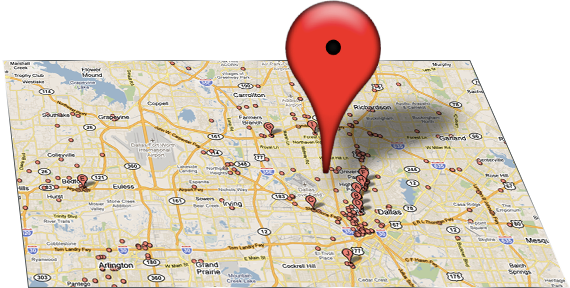 Local SEO in 5 Easy Steps
Local SEO in 5 Easy Steps Todd Bryson of Local Site Submit Shares SEO Tips For Local Businesses At #Pubcon 2013
Todd Bryson of Local Site Submit Shares SEO Tips For Local Businesses At #Pubcon 2013 How to Win at Local SEO With Reviews, Citations, and Local Events
How to Win at Local SEO With Reviews, Citations, and Local Events
- Bio
- Google+
- Latest Posts





Article source: http://www.searchenginejournal.com/seo-101-getting-started-local-seo-scratch/127749/

